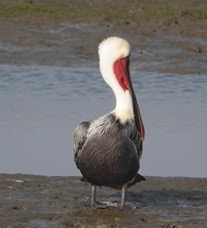Brown Pelican

ComingsBirds.com
to the beauty of birds

- Home California Birds
- SLIDESHOW
- SUMMARY OF ALL BIRDS
- MOVIES
- American Avocet
- American Coot
- Blackbirds/Crows
- Blue-grey gnatcatcher
- Brant
- Brown Pelican
- Chickade Mountain
- Comings' Backyard
- Common Loon
- Curlew Long-billed
- Dowitcher Long-billed
- Dowitcher Short-billed
- DUCKS
- EGRETS
- Dunlin
- Godwit Marbled
- Goldfinch Lesser
- GREBES
- Gnatcatcher Blue-grey
- Grosbeak Black-headed
- Gull California
- HUMMINGBIRDS
- Gull Heermann's
- Heron Black-crowned
- Heron Great Blue
- House Finch
- Jays
- Killdeer
- Merganser Red-breasted
- Nutcracker Clark's
- NutmegMannikin.com
- Other Birds
- Phainopepla
- Phoebe Say's
- Plover Black-bellied
- Plover Western Snowy
- Quail California
- Kittywake Black-legged
- Recent Additions
- Roadrunner Greater
- Sandpiper Least
- Sandpiper Western
- Sally's Fish
- Sanderling
- Shore Birds Other
- Skimmer Black
- Sparrow White-crowned
- Song Sparrow
- Stilt Black-necked
- Surf Scoter
- Swallow Tree
- Teal Blue-winged
- Teal Green-Winged
- Teal Cinnamon
- Tern Common
- Tern Elegant
- Turnstone Black
- Turnstone Ruddy
- Western Meadowlark
- Whimbrel
- Willet
- Yellow Leggs
- WOODPECKERS
- Template
- Contact Me
The Brown Pelican (Pelecanus occidentalis) is a North American bird of the pelican family, Pelecanidae. It is one of three pelican species found in the Americas and one of only two that feed by diving in water. It is found on the Atlantic Coast from Nova Scotia to the mouth of the Amazon River, and along the Pacific Coast from British Columbia to northern Chile, including the Galapagos Islands.
The brown pelican mainly feeds on fish, but occasionally eats amphibians, crustaceans, and the eggs and nestlings of birds. It nests in colonies in secluded areas, often on islands, vegetated land among sand dunes, thickets of shrubs and trees, and mangroves. Females lay two or three oval, chalky white eggs. Incubation takes 28 to 30 days with both sexes sharing duties. The newly hatched chicks are pink, turning gray or black within 4 to 14 days. About 63 days are needed for chicks to fledge. Six to 9 weeks after hatching, the juveniles leave the nest, and gather into small groups known as pods.
The brown pelican is the national bird of Saint Martin, Barbados, Saint Kitts and Nevis, and the Turks and Caicos Islands, and the official state bird of Louisiana. It has been rated as a species of least concern by the International Union for Conservation of Nature. It was listed under the United States Endangered Species Act from 1970 to 2009, as pesticides such as dieldrin and DDT threatened its future in the Southeastern United States and California. In 1972, the use of DDT was banned in Florida, followed by the rest of the United States. Since then, the brown pelican's population has increased. In 1903, Theodore Roosevelt set aside the first National Wildlife Refuge, Florida's Pelican Island, to protect the species from hunters.
The brown pelican was described by Swedish zoologist Carl Linnaeus in the 1766 12th edition of his Systema Naturae, where it was given the binomial name of Pelecanus occidentalis. It belongs to the New World clade of the genus Pelecanus.
P. o. californicus (Ridgway, 1884) – This subspecies breeds on the Pacific coast of California and Baja California, and south to Jalisco. Its non-breeding range extends north along the Pacific coast to British Columbia, and south to Guatemala. It is rarely found in El Salvador.
The brown pelican is the smallest of the nine pelican species, but is often one of the larger seabirds in their range nonetheless. It measures 3 ft 3 in to 5 ft 0 in in length and has a wingspan of 6 ft 8 in to 7 ft 6 in).
© 2009 David Comings Contact Me




